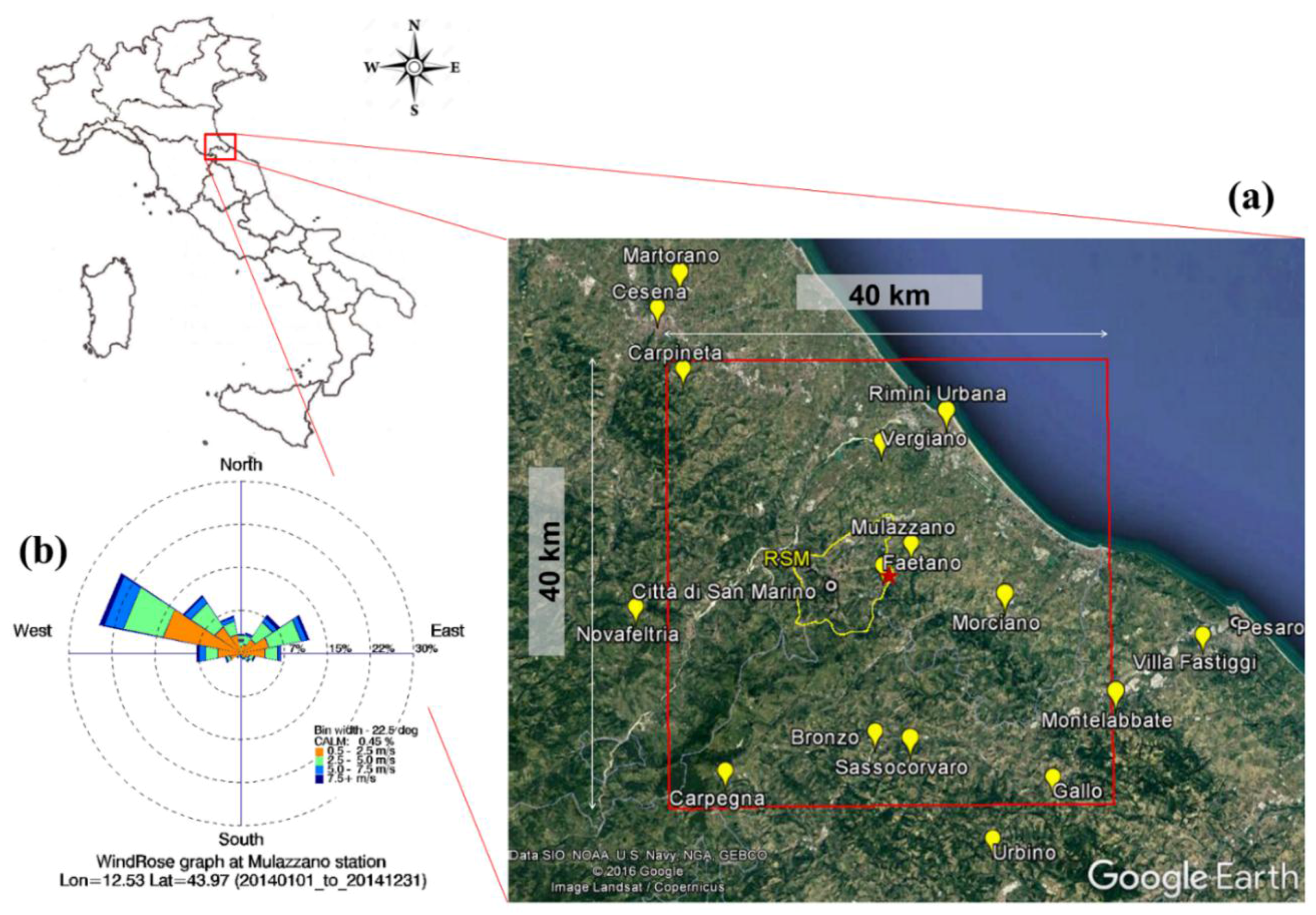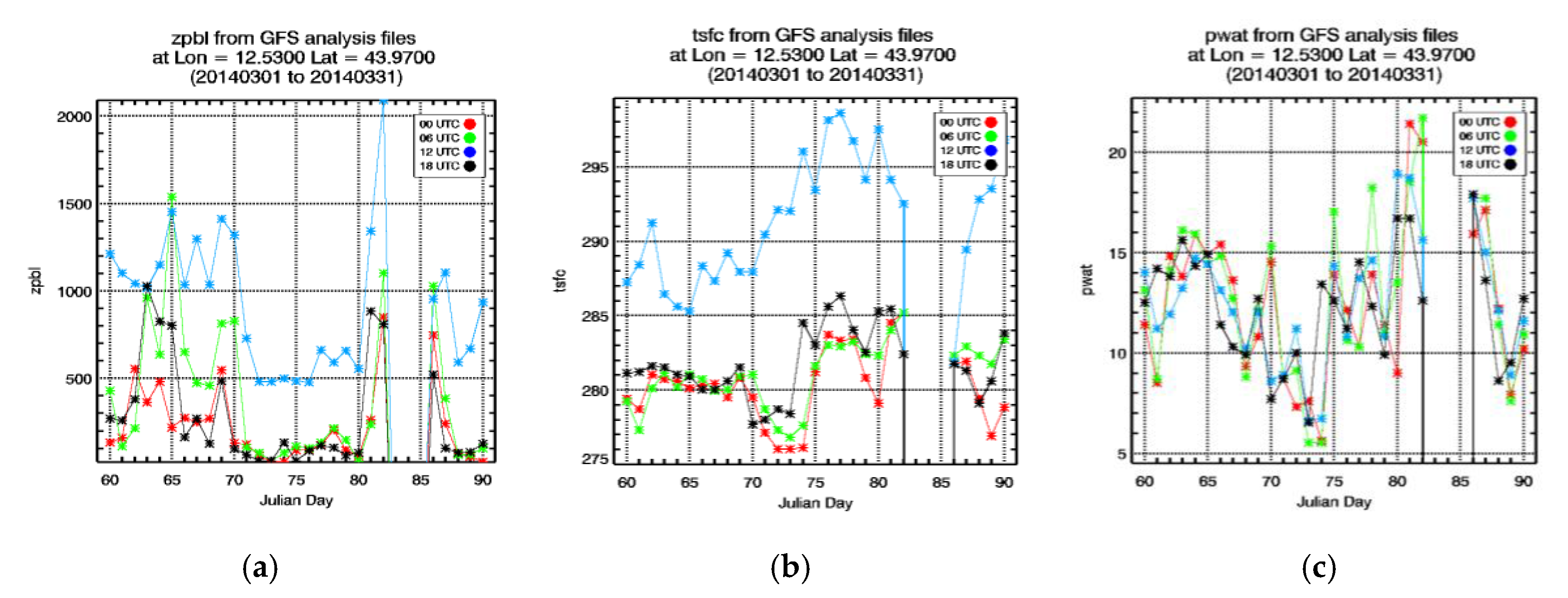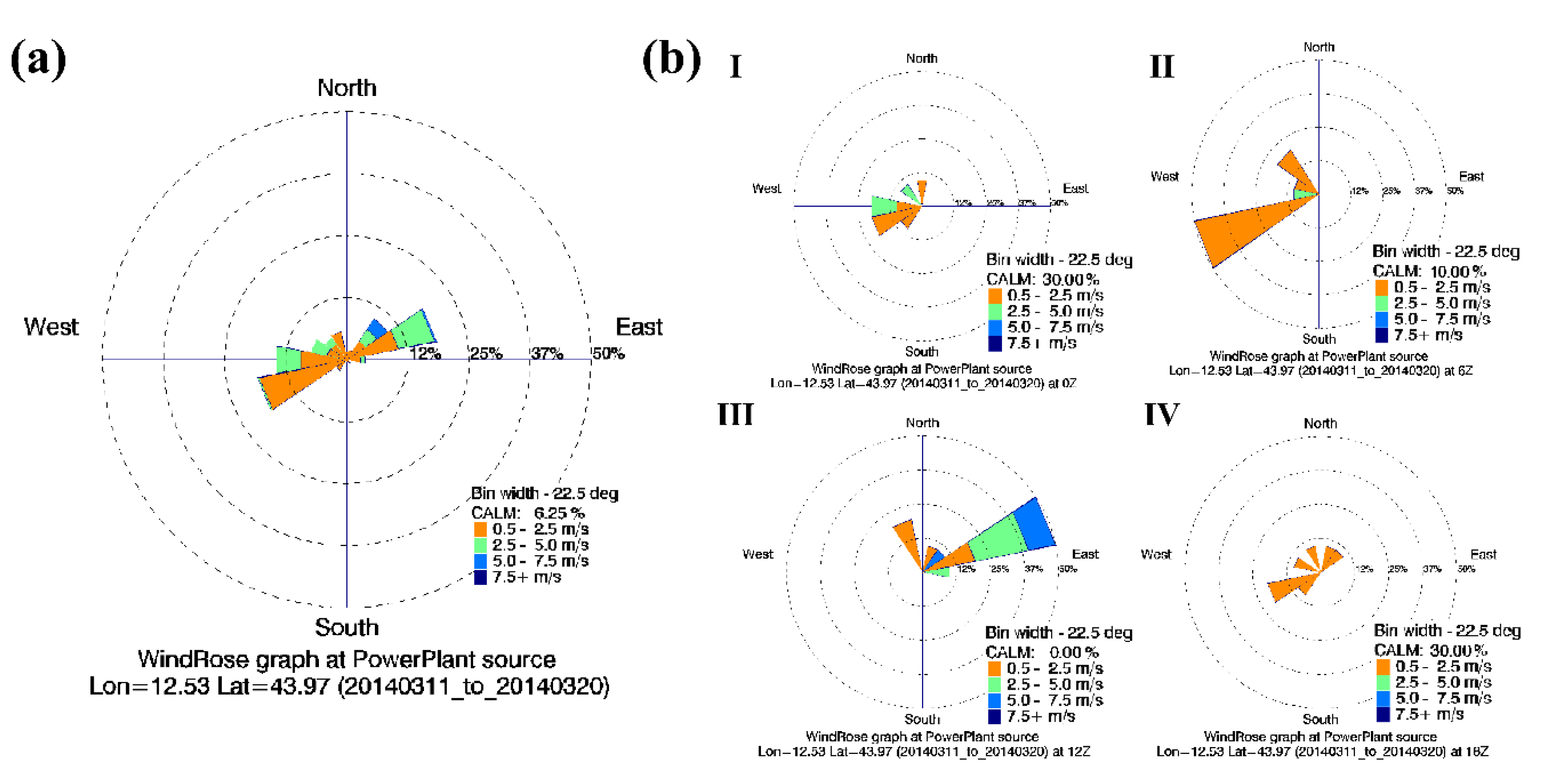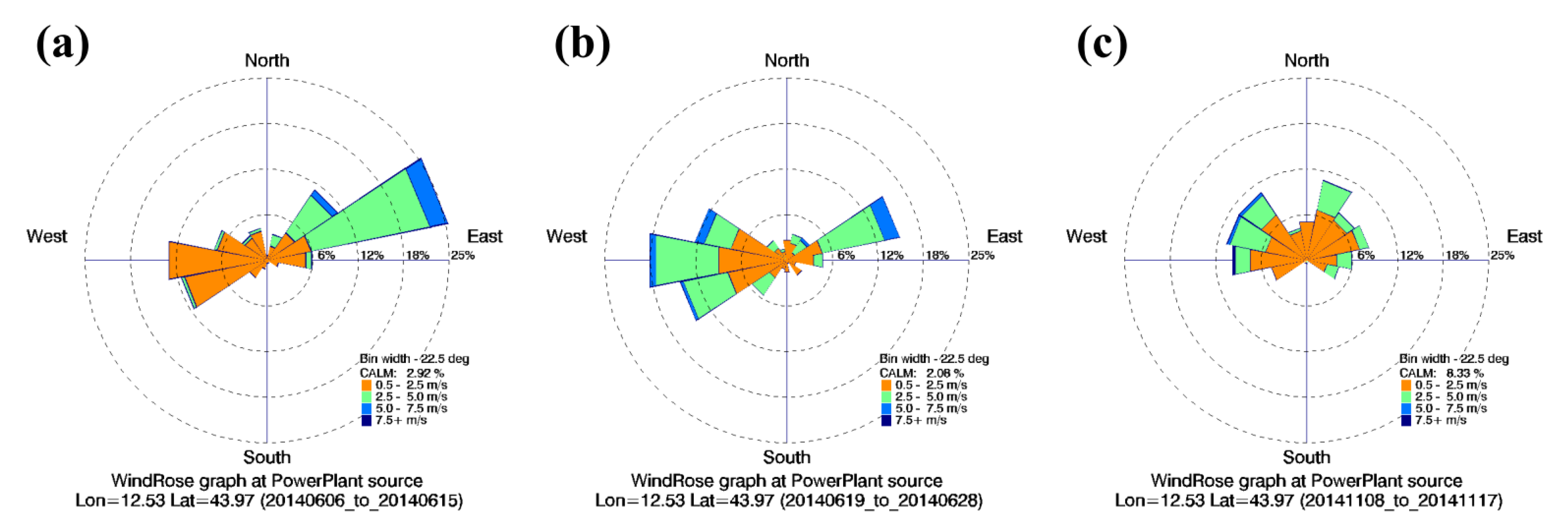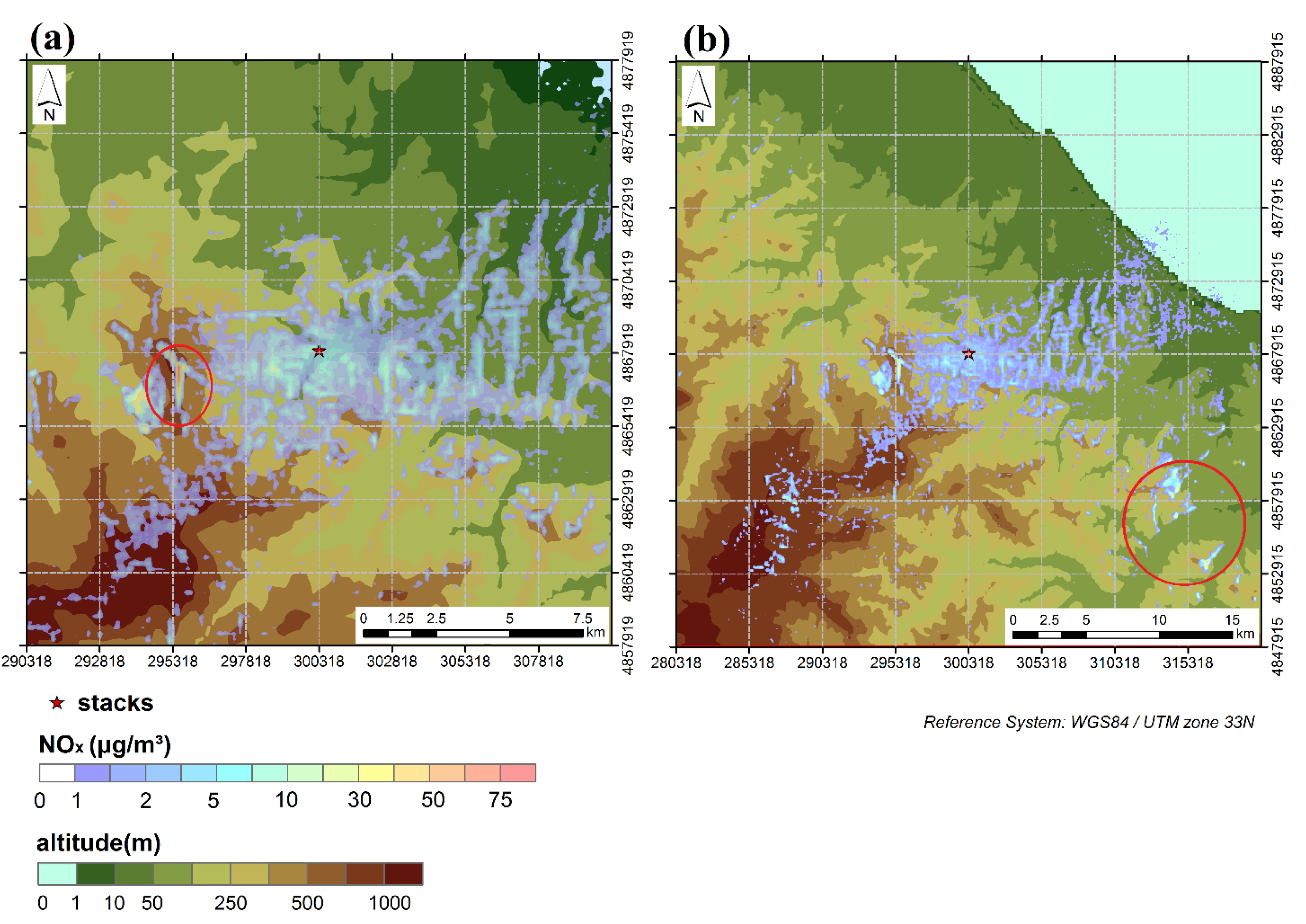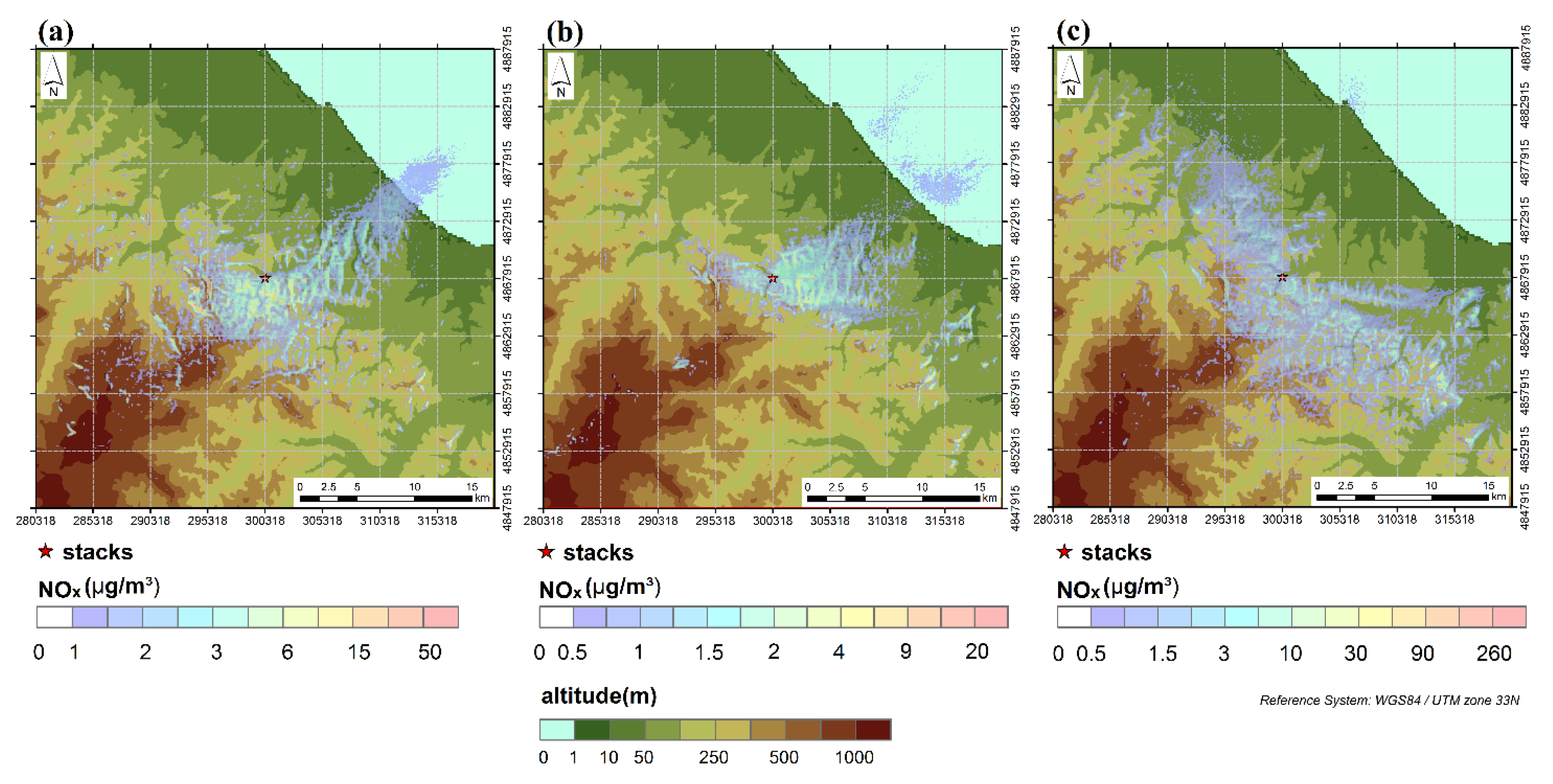1. Introduction
The United Nations Framework Convention on Climate Change (UNFCCC) set the ultimate objective to prevent hazardous anthropogenic interference with the climate system.
To meet this goal, the European Commission promotes and supports the reduction in energy consumption, the increase in energy efficiency, the increase in energy production from renewable sources and the reduction in greenhouse gas (GHG) emissions; these commitments were set out in the Directive 2009/29/EC [
1], and commonly called European 20-20-20 targets.
To fulfill the purposes of the Directive 2009/29/EC, the European Commission planned preliminary actions, including the promotion of the “cogeneration” [
2]. Combined heat and power (CHP) production, or cogeneration, implies that heat and electricity are produced simultaneously in a single process, coupling electricity production technologies with heat recovery equipment [
3]. Cogeneration is one of the most promising means of using existing advanced technologies for sustainable energy production.
CHP helps to reduce the environmental impact of power generation, because its self-production of electric power reduces the needs of electricity supply from the electric energy network with respect to a traditional power plant. Therefore, the pollutant (mainly NO
x, SO
x, and PM
10) and GHG emissions due to conventional electricity generation, which impact on air quality both at local [
4] and at global scale [
5], are avoided. Estimates by the European Environmental Agency [
6] of the avoided CO
2 emissions by the use of CHP led to the classification of cogeneration as a low carbon technology.
For these reasons, environmental policies support the diffusion of cogeneration plants: the share of electricity produced from CHP in the EU-27 is growing since 2008 [
7]. Nevertheless, the atmospheric impact of a cogeneration plant must be assessed, and the ground-level concentration of emitted pollutants must be compared with the air quality regulatory limits. That impact depends on the plant emission performance and on the dispersion of its stack emissions in atmosphere, i.e., the meteorological conditions and the local landscape features may also be relevant.
Economic sustainability of CHP plants is strongly influenced by the environmental impact of their atmospheric emissions [
8], and therefore, by the topographic setting of plant location. The stack emissions are a key factor in assessing the plant impact on local air quality, but basing this impact simply upon the exhaust mass flow rate of the pollutants and/or its annual atmospheric emissions would lead to partial and inaccurate results. A realistic simulation of pollutant dispersion is needed to properly assess the economic costs of atmospheric impact by the plant. Moreover, the availability of accurate and extended (both in time and space) pollutant concentration fields, having a suitable spatio-temporal resolution, reduces the uncertainty in estimates of population exposure to atmospheric pollution [
9].
Several studies based the environmental impact by atmospheric emissions using only statistical models, e.g., Land Use Regression models in urban areas [
10] or Geographically Weighted Regression models in larger domains [
11]. This type of models fails in estimating the impact by future point emissions, contrarily to dispersion models. Atmospheric dispersion models represent another important tool for atmospheric impact assessment of the stack emissions of power plants. These models allow one to simulate the spatial distribution of pollutants, in order to forecast the impact of an emitting source on air quality, or to identify the contribution of different sources, and support policy strategies for air pollution control.
Very few studies in the literature combined both a statistical and a dispersion model [
12], moreover, they generally use simplistic dispersion tools (e.g., Gaussian models), which are based on strong assumptions, and suitable only in rarely occurring conditions. The present study combines the use of a statistical and a dispersion modelling tool, and it is featured by a Lagrangian dispersion model, representing a novelty and providing improved concentration fields for reliable economic assessments of the plant and exposure studies.
The Directive 2008/50/EC [
13] and Italian law (D.Lgs. 152 03/04/2006) allow the application of dispersion models for the assessment of air quality, and set the uncertainty which may be applied to a simulation result. The models available are many, featured by different degrees of complexity and different performances. Simulation results produced by different models may not be comparable during some specific atmospheric conditions, such as low winds [
14] or local scale winds of breeze, and also over complex topography [
15,
16,
17,
18,
19,
20,
21].
The development of a natural gas-fired tri-generation power plant (520 MW Combined Cycle Gas Turbines (CCGT) + 58 MW Tri-generation) in the Republic of San Marino, a small independent enclave placed in Northern Italy, is under evaluation. The power plant will have the largest efficiency among all existing plants over the Italian peninsula, it will completely fulfill the energy needs of San Marino, and it will also provide energy to Italy.
The project could benefit from existing and near infrastructures, as gas pipelines and electricity grids export energy to Italy. Moreover, the Italian regions south of San Marino would have a major advantage from the plant, because of the lower number of cogeneration units and the lower electricity production capacity in these areas [
22]. The project includes the use of cogeneration in combination with heat-pump technology and plug-in vehicles as part of a renewable electric grid, in order to make San Marino a “smart” society [
23], with a more robust energy infrastructure which might drive economic growth.
The present work investigates the provisional impact assessment of atmospheric emissions from the cogeneration plant stacks, which could be installed in the Republic of San Marino, in the framework of the regulatory limits put by Italian law (D.Lgs. 152 03/04/2006 and D.Lgs. 46 04/03/2014, implementation of Directive 2010/75/UE [
24]). Both technical and socioeconomic aspects of that project have great relevance, yet the environmental implications must be evaluated. Among these, the air pollution caused by the plant emissions, which receive more attention by the population, directly affecting human health.
The study includes simulation results from a Lagrangian dispersion model of the power plant during a worst-case scenario, and three periods well representative of low, moderate, and large atmospheric dispersion conditions, respectively. Only NOx and CO were simulated, being the two compounds having regulatory emission limits for this power plant; since the simulated concentrations of CO were largely lower than the regulatory limits, the simulation focused only on NOx. Finally, a statistical analysis of concentration fields has been performed to assess the impact of atmospheric emissions on local air quality, and on exceedance of air quality regulatory limits.
4. Software and Datasets
The simulation of the dispersion of the pollutant emitted by the plant was performed by the software package ARIA INDUSTRY (Arianet srl, Milano, Italy & ARIA Tehcnologies Boulogne Billancourt, France), which includes the dispersion model SPRAY, the diagnostic wind field meteorological model SWIFT (former MINERVE [
25,
26,
27,
28]) and the turbulence model SURFPRO [
29]. SPRAY is a Lagrangian stochastic model for the simulation of the dispersion of passive pollutants in a complex terrain and non-homogenous conditions, under calm and low wind events [
14]. The model operates in non-stationary conditions by approximating temporal variations in successive stationary states. SPRAY gives highly reliable simulations of pollutant dispersion close to the release source point [
30,
31], and it is able to simulate deposition-decay phenomena. SPRAY supplies a three-dimensional concentration field, vertically subdivided into grid cells at different terrain-following layers, and vertically stretched to obtain higher resolution near the ground.
For the present study, a local scale simulation was performed: the diagnostic wind and temperature fields were computed over the spatial domain of 40 × 40 km
2 (
Figure 1a), divided into a horizontal grid of 200 m square cells, and into a vertical grid of 10 layers from the ground to 1500 m above ground level. The pollutants concentration fields were computed over two spatial domains, the former of 40 × 40 km
2 divided into a horizontal grid of 200 m square cells, and the latter of 20 × 20 km
2, with a spatial resolution of 100 m. For both, the studied domain is centered at the release source point, i.e., the location of power plant stacks. Each single stack is simulated as an independent emitting source; the stacks have the same location at the simulation spatial scale. For the computation of the pollutant concentration vertical profiles, a vertical grid of 10 layers from the ground to 1500 m was used. The thickness of the first layer is set to 10 m, starting from the ground level. The emission sources of the power plant were simulated as a non-stop continuous release source points.
Lagrangian models are the used to properly simulate the pollutant dispersion in a complex terrain [
14,
15,
17,
19,
20,
21]: SPRAY does not include atmospheric photochemical processes, and only few models coupling Lagrangian dispersion with atmospheric chemistry exist in the literature of [
32,
33,
34]. This study aimed to assess the impact of NO
x stack emissions on local air quality: since regulatory emission limits for combustion plants are set for NO
x (2010/75/UE), while for air quality are set for NO
2 (2008/50/EC), the simulation of NO
x dispersion represents a conservative and precautionary approach, since NO
x includes both NO
2 and NO. Moreover, the impact of emissions is highest in winter, when photochemistry is at its minimum, consistently with the conservativeness of the approach used, but with a lower simulation bias by neglecting the NO
x reactivity.
The year 2014 was chosen as reference period, being the most recent year not affected by the El Niño phenomenon. Both experimental and simulated meteorological data were used as input data for the meteorological model. The measured meteorological data were obtained by 16 ground-based meteorological stations of the Italian Environmental Agency network surrounding the power plant site in RSM, as mapped in
Figure 1a. The wind rose graph for the meteorological ground station of Mulazzano (the closest to the source), for the year 2014 of hourly-measured wind data is reported in
Figure 1b. The wind rose shows that the wind climate in the site is driven by mesoscale circulation, mainly characterized by moderate winds blowing from North West-West and, with lower frequency, from North East-East.
The simulated input data consist of a vertical wind profile close to the source point provided by the mesoscale COSMO atmospheric model (LAMA dataset), operating by Arpae Emilia Romagna [
35,
36]. The simulation domain for Italian application of COSMO covers an area of about 2000 × 2000 km
2 with a horizontal resolution of 7 km. The LAMA dataset covers the central part of the COSMO domain, with an area of 1200 × 1200 km
2.
Ground elevation data were provided by the Shuttle Radar Topography Mission through United States Geological Service (USGS), sampled at 3 arc-seconds, with a resolution of about 90 m (Version 4.1), while the land use/land cover (LULC) dataset was extracted by the European CORINE Land Cover (CLC) 2012 inventory [
37]. To fulfill the requirements of SPRAY, the 44 LULC classes provided in the third level classification of the CLC were grouped in 21 classes [
38].
6. Results and Discussion
For each period of analysis, the simulations were performed with an hourly time-step, according to the hourly meteorological input data. The plant was considered under steady-state operation, where its specific features are reported in
Table 1.
As introduced in
Section 2, the emitted NO
x concentration in dry exhaust gas (based on 15 % O
2) was set to 50 mg N m
−3, as provided by the manufacturer, and slightly below the emission limit of 52 mg Nm
−3, and CO concentration in dry exhaust gas (based on 15% O
2) was assumed equal to the regulatory limits (100 mg N m
−3).
The simulated concentrations were compared with the air quality limits for NO
2, and CO (D.Lgs. 155 13/08/2010) reported in
Table 2. Since the simulated CO ground concentration results were always largely lower than the regulatory limits, they were omitted.
It is worth noting that the maps in
Figure 5,
Figure 6 and
Figure 7 and all further analysis include only simulated ground concentrations higher than 1 μg m
−3; these latter concentrations were referred in the rest of the text as plume concentrations. The power plant stacks, due to the map resolution, have the same location at the map scale (red star) and represent the center of the domain.
6.1. NOx Average Hourly Concentration Maps for the Most Critical Period
The simulation was performed at first for the most critical period, ranging from March 11th to March 20th, 2014.
Figure 5 shows the maps of the plume emitted by the power plant, as average hourly NO
x concentration in the first atmospheric layer (10 m) mapped over the Digital Terrain Model (DTM) of the spatial domain (20 × 20 km
2 in
Figure 5a and 40 × 40 km
2 in
Figure 5b respectively). The simulated plume in
Figure 5a appears stretched approximately from West to East over the 20 × 20 km
2 domain. The simulated NO
x concentrations were compared to air quality limits for NO
2 (
Table 2). The average hourly NO
x concentration in the investigated period ranges from 1 μg m
−3 to a maximum value of 65 μg m
−3, at about 5 km West from the power plant and close to the Mount Titano relief. Mount Titano represents a physical barrier to the plume dispersion, causing air stagnation with local accumulation of the power plant emissions. The maximum hourly average concentration (65 μg m
−3) occurs over the Eastern slope of Mount Titano and next to San Marino City as highlighted in red in
Figure 5a. The plume average concentration at ground over the domain is lower than 2 μg m
−3, largely below the two regulatory limits for hourly peak (200 μg m
−3) and annual mean (40 μg m
−3) NO
2 concentration. The vertical profiles of NO
x average hourly concentration along the western plume stretch for the critical period were investigated (not shown). The concentration vertical profiles calculated at 1, 3, 5, and 10 km from the release source show the maximum concentration at about 700 m of altitude, at 5 km from the source, where the plume impacts the steep slope of the Mount Titano. To better investigate the atmospheric dispersion towards the Adriatic Sea, the concentration field was also computed on a larger domain (40 × 40 km
2), with a horizontal grid step of 200 m.
Figure 5b shows the maps of average hourly NO
x ground concentration. The plume concentration for this larger domain were generally lower than the NO
2 regulatory limit, ranging from 1 μg m
−3 to maximum values of about 90 g m
−3, with an average plume value lower than 2 g m
−3. In addition to the already mentioned concentration peak (65 g m
−3) close to the Mount Titano, six non-contiguous cells ~25 km SE of the plant had a concentration peak of average hourly concentration between 40 g m
−3 and 90 g m
−3 (see the red circle in
Figure 5b). At that greater distance from the stacks, the plume is dispersed upwards in the atmosphere and downwards to the ground, and natural obstacles (e.g., hills) may cause occasional concentration peaks. The concentration peak on the slope of Mount Titano is due to the recurrent Northeast-East winds, as shown by the wind rose in
Figure 4a, while NW winds are responsible for the single scattered peaks occurring South-East of the plant (
Figure 5b).
6.2. NOx Concentration Maps at the Synoptic Hours
The wind roses previously reported (
Figure 4b) show how the effects of local breeze circulation are important: at the four synoptic hours (00, 06, 12, 18 UTC), a predominant wind direction is evident (see
Section 5.1). This effect was investigated on a particular day within the critical period: March 14th, 2014, as the most representative. The maximum average hourly NO
x ground concentration for March 14th, 2014, was 110 µg m
−³, and occurred close to the Mount Titano, while the average plume value for the domain is equal to 2.2 µg m
−³.
The maps of average hourly NO
x ground concentration at the four synoptic hours 00, 06, 12, 18 UTC on the spatial domain of 40 × 40 km
2 are reported in
Figure 6a–c. A single map was provided for the two synoptic hours 00 and 06 UTC, due to their similar dominant winds from West-Southwest. At 00 and 06 UTC the plume moves East, while at 12 UTC the plume is transported South by the wind and finally, at 18 UTC, wind calm prevails. It is worth noting that this local sea breeze circulation effect should be considered in combination with the prevailing atmospheric circulation at mesoscale.
6.3. NOx Average Hourly Concentration Maps for the Summer and Fall Periods
The average hourly NOx concentration in the first atmospheric layer (10 m) in summer (from June 6th to June 15th, 2014 and from June 19th to June 28th, 2014) and in fall (from November 8th to November 17th 2014) periods was simulated considering both the smaller (20 × 20 km2) and the wider (40 × 40 km2) domain. The maps for the wider domain are here reported and discussed, as more representative.
Figure 7a shows the maps of the plume emitted by the power plant mapped over the DTM on the wider domain for the first summer period. The plume appears stretched approximately from NE to SW, consistently with the wind rose in
Figure 5a, where the much more intense winds blow from Northeast direction. Therefore, the plume is dispersed towards the Mount Titano on the West of the source. The average hourly NO
x concentration for the plume in this summer period ranges from 1 μg m
−3 to a maximum of 77 μg m
−3, obtained close to Mount Titano, slightly Southwest from it. The plume average value through the domain is about 2 μg m
−3.
The plume for the second summer period (
Figure 7b), is stretched approximately from West-Northwest to East, consistently with the wind rose in
Figure 5b. Since in this period the Western winds are the most intense, the plume is mainly dispersed towards the Adriatic Sea coast. The average hourly NO
x concentration for the plume in this second summer period ranges from 1 μg m
−3 to a maximum of almost 30 μg m
−3, occurring at 15–18 km East South-East of the power plant; concentration values of about 12 μg m
−3 are obtained on the Eastern slope of Mount Titano relief. The plume average value through the domain is lower than 2 μg m
−3.
In
Figure 7c the map of the plume for the fall period is shown: the plume is stretched approximately from Northwest to Southeast (see the corresponding wind rose in
Figure 5c). In this period, the Northwest-West winds are the most intense, dispersing the plume towards the mountain relieves to the Southeast side of the source. The average hourly NO
x concentration ranges from 1 μg m
−3 to a local maximum of almost 390 μg m
−3, occurring 15 km Southeast of the power plant. Fifteen non-contiguous domain cells at 20–25 km SE of the plant showed high concentration with an average between 40 µg m
−3 and 90 µg m
−3; the area is impacted also during the critical period, when, however, the concentration peaks fall in different domain cells (
Section 6.1). Concentrations of about 29 μg m
−3 are on the Eastern slope of Mount Titano. The plume average value through the domain is about 2 μg m
−3.
6.4. Pollution Roses and Exceeding of Regulatory Limits
The NO
x pollutant roses for the four simulation periods are shown in
Figure 8a–d. The wind data for the source point at the plant stack elevation and the hourly NO
x ground concentration were used to obtain a conditional bivariate probability function (CBPF [
44]): each CBPF estimates the probability that a specific concentration range is observed within a given wind sector (of 5 degrees width), depending upon wind speed. CBPFs in
Figure 8 show the probability frequency of NO
x concentration higher than the hourly regulatory limit for each wind speed and direction class.
CBPFs were computed using wind data by the diagnostic model SWIFT at the source point, and the average simulated NO
x concentration in a 100 m × 700 m area over the Eastern slope of Mount Titano, where recurrent concentration peaks are expected. The concentration range used to compute CBPF considered levels larger than the regulatory limit of 200 μg m
−3. Plots in
Figure 8 show that in March (
Figure 8a), the exceedances are triggered by moderate Eastern winds, in June (
Figure 8b,c) exceedances have a very low probability, and in November, the exceedances over that small area of the Eastern slope of Mount Titano are related to wind calm and slow Northestern winds.
The outcome of CBPF was compared to the wind roses of each investigated period (
Figure 3a and
Figure 4a–c): CBPFs show the percentage of wind conditions that may be responsible of concentration peaks around the Mount Titano area, while the wind rose graph for the entire year 2014 (
Figure 1b) shows that the frequency of the wind events blowing from Northeast-East in the year 2014 is of about 11%, while the calms correspond to less than 1% in the year. Therefore, the regulatory limit for average hourly NO
2 concentration is expected to be exceeded more than 18 times a calendar year, but limited to the focus area on the Eastern slope of Mount Titano. Considering only the simulation periods, in the focus area, the regulatory limit for NO
2 is exceeded 33 times in total (14 times in March, 13 in November, 2 and 4 in the two summer periods respectively). Nonetheless, in the nearby domain cells, NO
x concentration sharply decreases, with results largely lower than the regulatory limits. Consistently with CBPF (
Figure 8), the 33 exceedances occur in presence of wind events blowing from Northeast-East and of wind calms.
7. Conclusions
The present work investigated the impact assessment of the NOx atmospheric emissions from a cogeneration plant, which will be installed in the area of Republic of San Marino, considering the regulatory limits for the combustion plants set by the Italian law. The environmental impact was performed via numerical simulations of atmospheric dispersion of the exhaust gases emitted from the cogeneration plant stacks and the results further analyzed by statistical models. The study considered both a worst-case meteorological scenario (critical period) in March 2014, and two summer and one fall representative period in 2014. The power plant was assumed under continuous non-stop operation. The resulting maps of hourly average simulated concentration at the ground level (i.e., in the first atmospheric layer starting from the ground, 10 m thick) showed values largely lower than the regulatory limits for air quality for NO2.
The results of the simulations for the largest of the two simulation domains (40 × 40 km2), both for the critical and the representative periods, showed at the ground level average hourly concentration fields featured by very low values, with local single peaks where the emission plume impacts the ground reliefs. These peaks occur in two different areas of the domain depending on the simulation period: an area over the SE slope of Mount Titano showing recurrently large concentration levels both in March and in the June periods, and an area at 20–25 km SE of the power plant. Peaks in this latter area occur in different domain cells depending on the simulation period, without the evidence of a recurring accumulation point, therefore, they should not give rise to persistent pollutant buildups.
Nevertheless, the NOx plume average concentration over the largest investigated is ca. 2 μg m−3. The wind rose graph for the entire year 2014 showed that the frequency of NE winds causing a concentration peaks over the slope of Mount Titano was of about 11%, and that the frequency of NW winds causing high concentration SE from the power plant is of about 12%, while wind calm frequency is lower than 1% per year. The pollution roses show that the regulatory limit for average hourly NO2 concentration is already exceeded more than 18 times during the investigated period, but limited to a steep area on the cliff of Mount Titano. Therefore, the power plant emissions are expected to meet the air quality limit for NO2 hourly average concentration (200 μg m−3) throughout the investigated domain, except around the area close to Mount Titano, where the hourly limit for NO2 is expected to be exceeded. Due to its location with respect to the source, this area may be considered the most exposed to a local accumulation of pollutants emitted from the power plant. Yet, it is fortunately not a residential area, due to its steep morphology. Similarly, the power plant emissions will be expected to meet the annual limit (40 μg m−3) for mean annual NO2 throughout the investigated domain, except around the area close to Mount Titano. The limit for NO2 annual mean is expected not to be exceeded in the area SE of the power plant, even if several concentration peaks occur there, because these single peaks (in scattered domain cells) mainly occur in different areas of the domain for each simulated period, without the evidence of recurring accumulation points.
This study highlighted how the innovative combined use of a Lagrangian dispersion model (SPRAY) and of statistical models leads to an accurate assessment of the environmental impact by power plant emissions over a complex terrain and under unsteady wind conditions. The project includes the use of cogeneration in combination with heat-pump technology and plug-in vehicles, as part of a renewable electric grid, in order to make San Marino a “smart” society [
23], with a more robust energy infrastructure which might drive economic growth.
